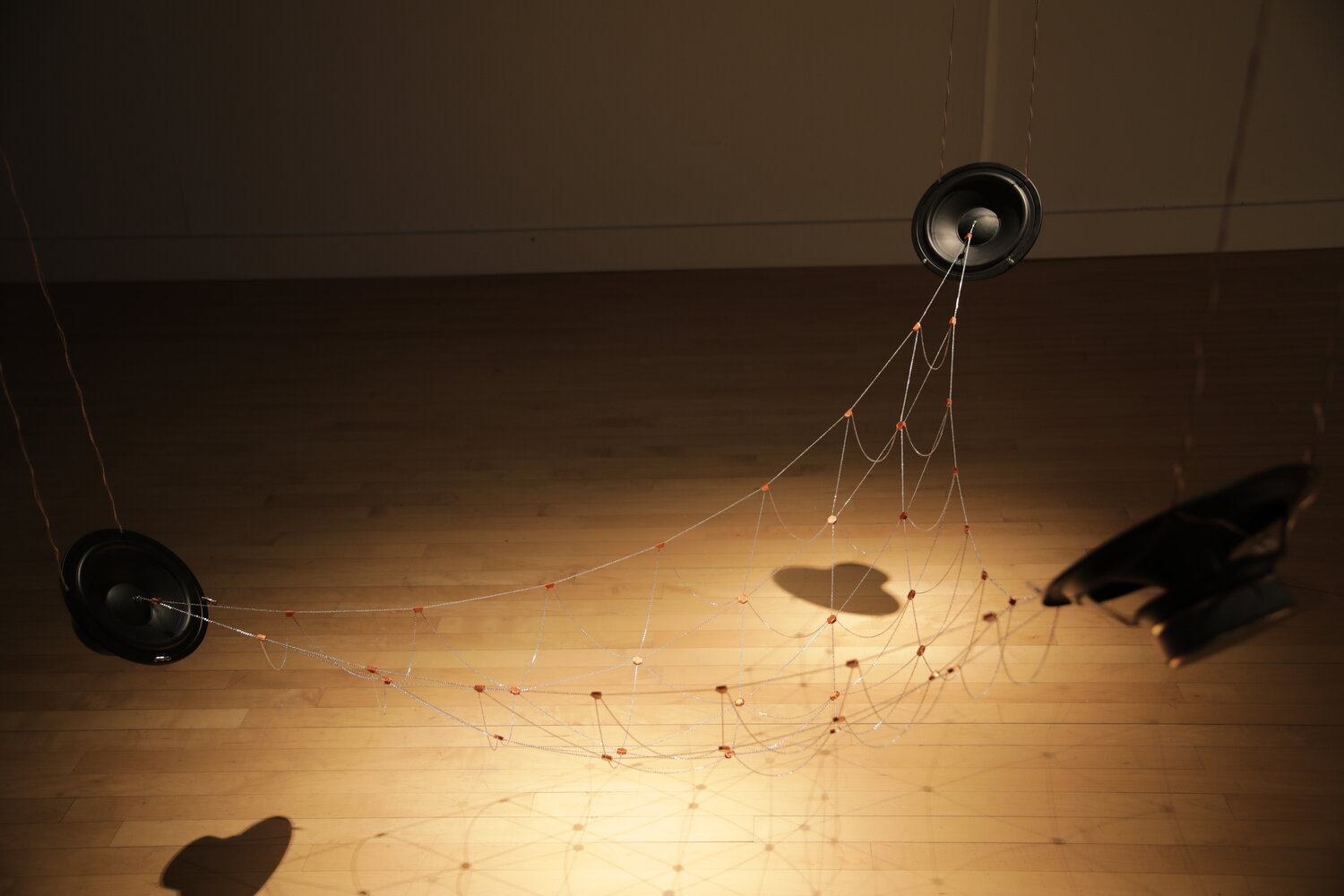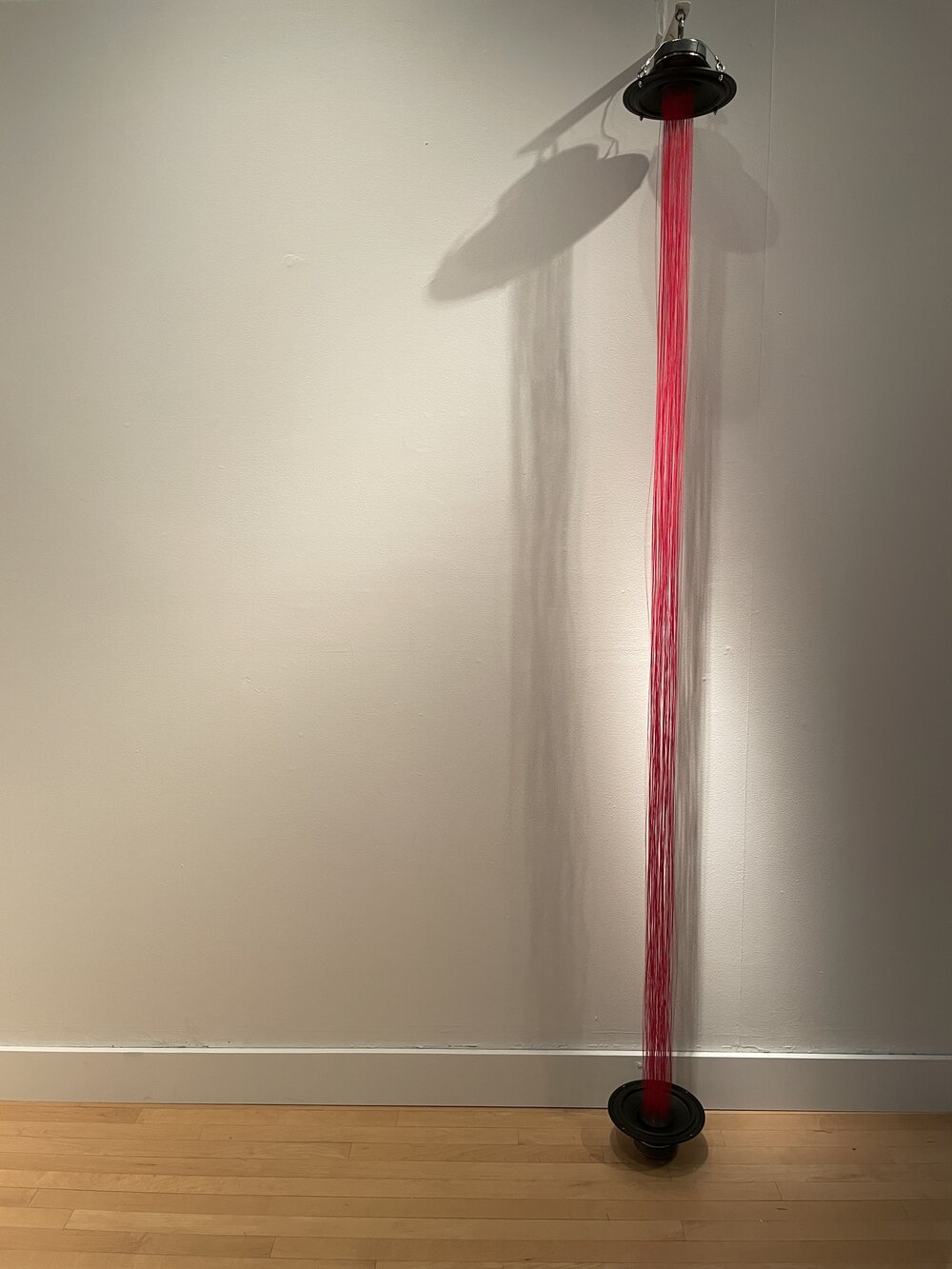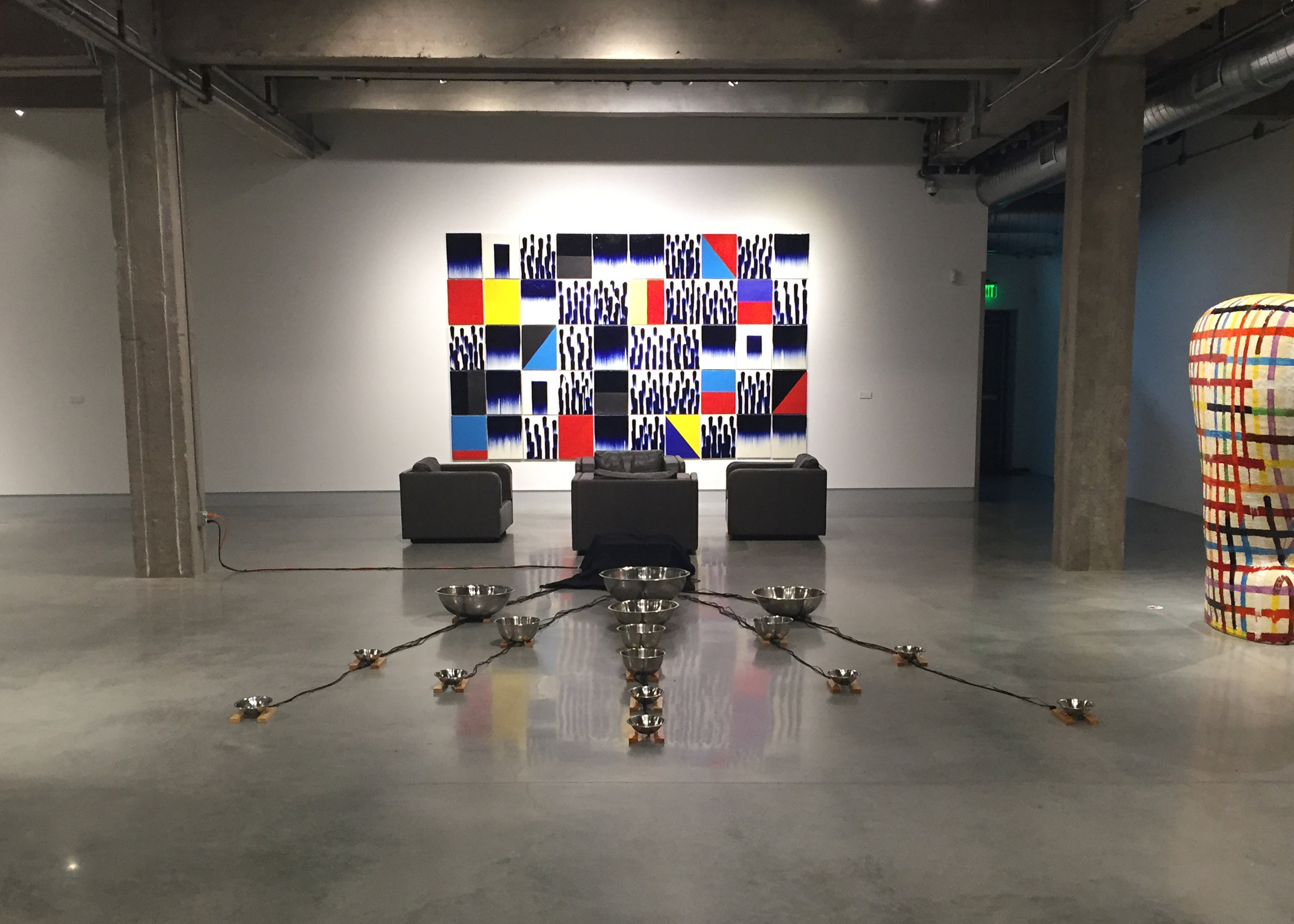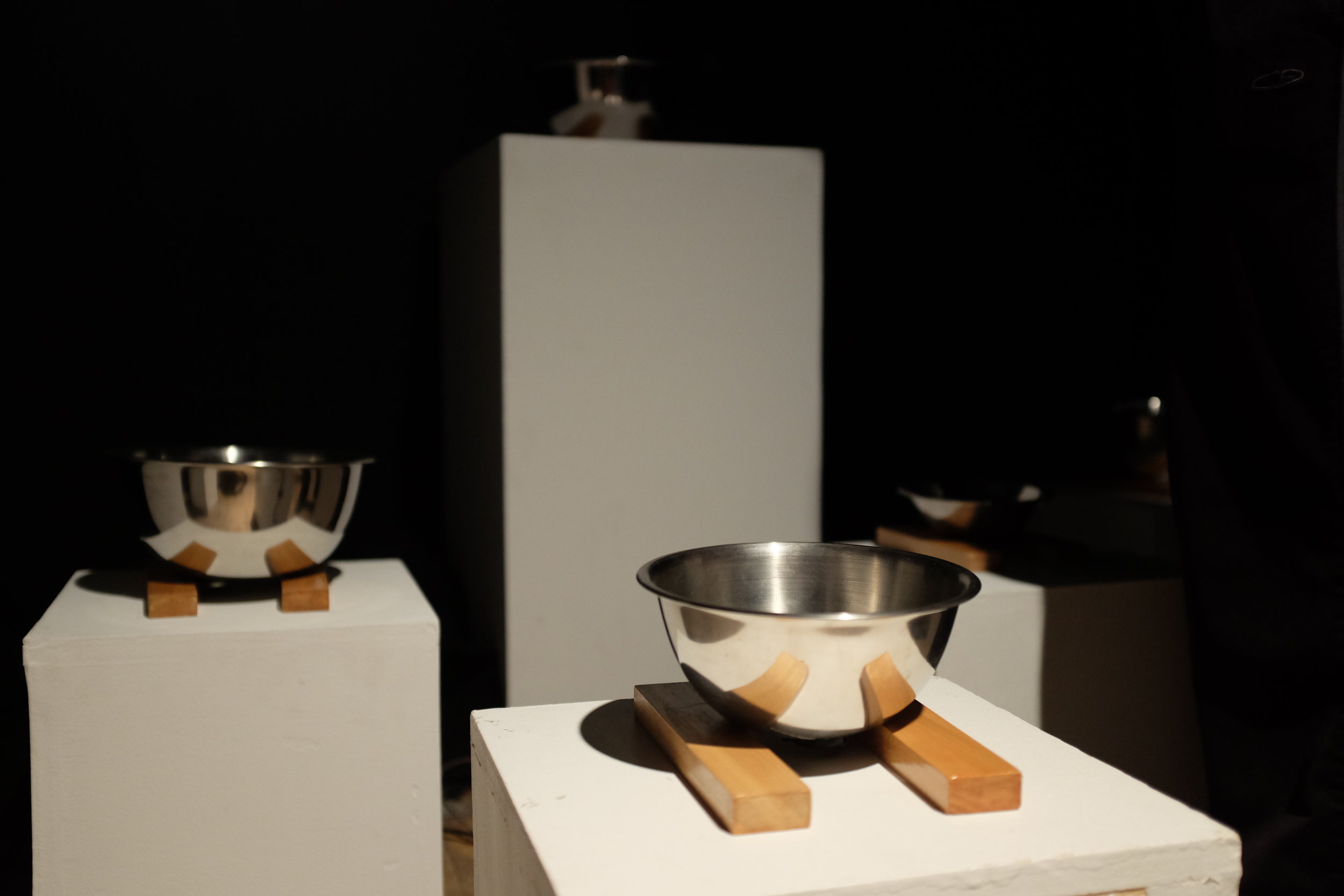About Jason
My practice occupies two distinct (but overlapping) realms: multimedia art and music.
I am a composer and performer of music for instruments, voices, and electronics. My compositions are born from direct collaboration with performers, and often includes electronic/acoustic interactions. As an electroacoustic performer, I am interested in connecting to audiences through embodied gesture, novel interfaces, and improvisation, using hardware synthesizers and computer code.
My art… more
reciprocation
a mutual exchange, an alternating motion.
The body is where sound is born. Sound is simply motion until the body transforms oscillation into sensation in a messy, subjective process.
From the material through which sound moves to the anatomical variations in each ear and brain, the chain of dependencies between sound and understanding is rife with distortion and occlusion. The physicality of sound and the phenomenon of listening are dependent on reciprocal movement and reciprocal intention. The four works in reciprocation reimagine loudspeakers – transforming them from “invisible” aural channels into sculptural objects to interrogate interpersonal relationships, (mis)communications, and the kinetic phenomenon of sound. While recorded audio is used to drive the loudspeakers and implicate the viewer-listener’s body, the heard sound is an artifact of the materials activated by the speakers’ movement. This was my thesis project for my MFA in Intermedia and Digital Arts from University of Maryland - Baltimore County.
-
reciprocationVideo documentation of the sculptures in "reciprocation," as installed at the Center for Art Design and Visual Culture at University of Maryland, Baltimore County (Jan-Mar 2021)
-
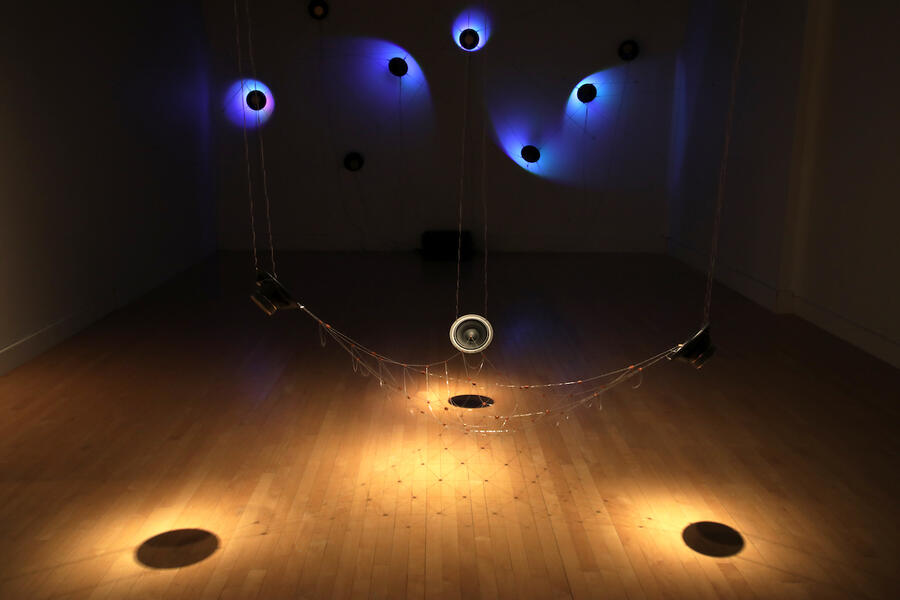 installation viewView of "fate" and "allegory" as installed at the CADVC in 2021.
installation viewView of "fate" and "allegory" as installed at the CADVC in 2021. -
installation view"fate" (right) and "harmonic curtain" as installed at CADVC in 2021.
-
 "trine" installation viewtrine – speakers, steel jewelry chain, 3D-printed plastic, 3-channel conversation (recorded November 17, 2019) 18’08” (loop) The audio playing through the speakers is from a recording of three intimate partners talking about their relationship with one another, rendered unrecognizable by converting each person’s speech into very low frequencies, but carrying the cadence of conversation. The mesh ripples up and down, carrying waves across its shimmering surface. Perfectly opposite phase is impossible among three speakers; one will always be moving in the same direction as at least one other. True reciprocal movement cannot ever be realized with these three bodies. Each speaker connects to the other along the side in individual, chained partnerships, and across the fabric of the polyamorous union.
"trine" installation viewtrine – speakers, steel jewelry chain, 3D-printed plastic, 3-channel conversation (recorded November 17, 2019) 18’08” (loop) The audio playing through the speakers is from a recording of three intimate partners talking about their relationship with one another, rendered unrecognizable by converting each person’s speech into very low frequencies, but carrying the cadence of conversation. The mesh ripples up and down, carrying waves across its shimmering surface. Perfectly opposite phase is impossible among three speakers; one will always be moving in the same direction as at least one other. True reciprocal movement cannot ever be realized with these three bodies. Each speaker connects to the other along the side in individual, chained partnerships, and across the fabric of the polyamorous union. -
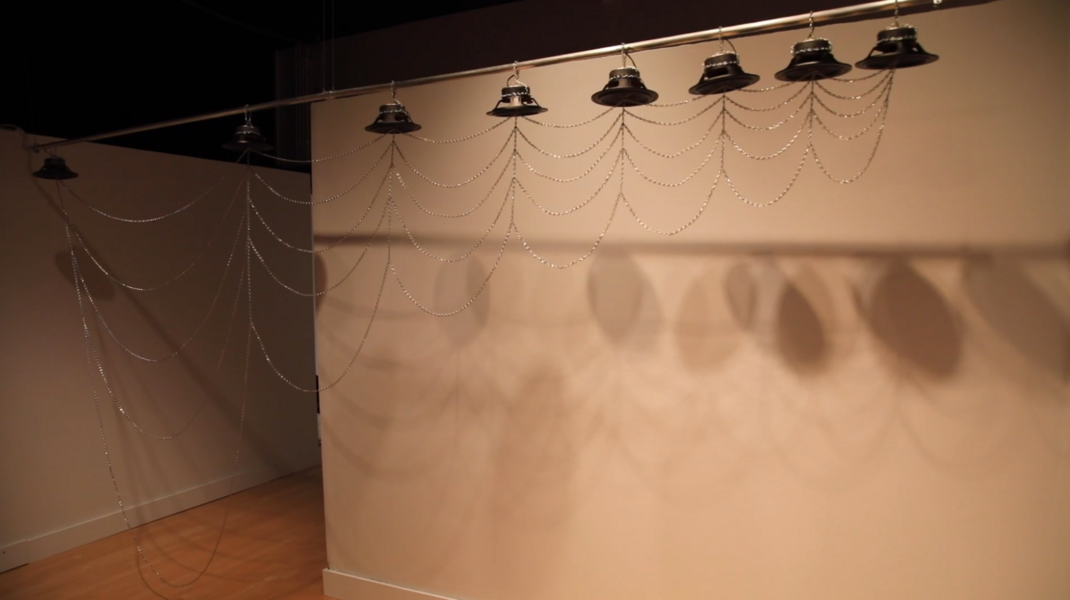 "harmonic curtain" installation viewharmonic curtain – speakers, steel jack chain, score on paper, 8-channel sound 60’00” (loop) Viewers are confronted with the tactile nature of sound when encountering harmonic curtain, installed above the entrance to the exhibition. The overall shape created by the series of hanging chains recalls the decorative fabric bunting of ornate drapery, rendered as a transparent and vibrating line drawing. The entire form of the work - spatially and temporally - is derived from the harmonic series, the naturally occurring relationship of resonating bodies that we interpret as consonance in music. Rather than hearing harmonic relationships, the viewer-listener experiences this pervasive and fundamental sonic principle through sight and touch. The work illustrates the connections between sound and matter, highlighting the complicated interactions of even simple vibrating systems.
"harmonic curtain" installation viewharmonic curtain – speakers, steel jack chain, score on paper, 8-channel sound 60’00” (loop) Viewers are confronted with the tactile nature of sound when encountering harmonic curtain, installed above the entrance to the exhibition. The overall shape created by the series of hanging chains recalls the decorative fabric bunting of ornate drapery, rendered as a transparent and vibrating line drawing. The entire form of the work - spatially and temporally - is derived from the harmonic series, the naturally occurring relationship of resonating bodies that we interpret as consonance in music. Rather than hearing harmonic relationships, the viewer-listener experiences this pervasive and fundamental sonic principle through sight and touch. The work illustrates the connections between sound and matter, highlighting the complicated interactions of even simple vibrating systems. -
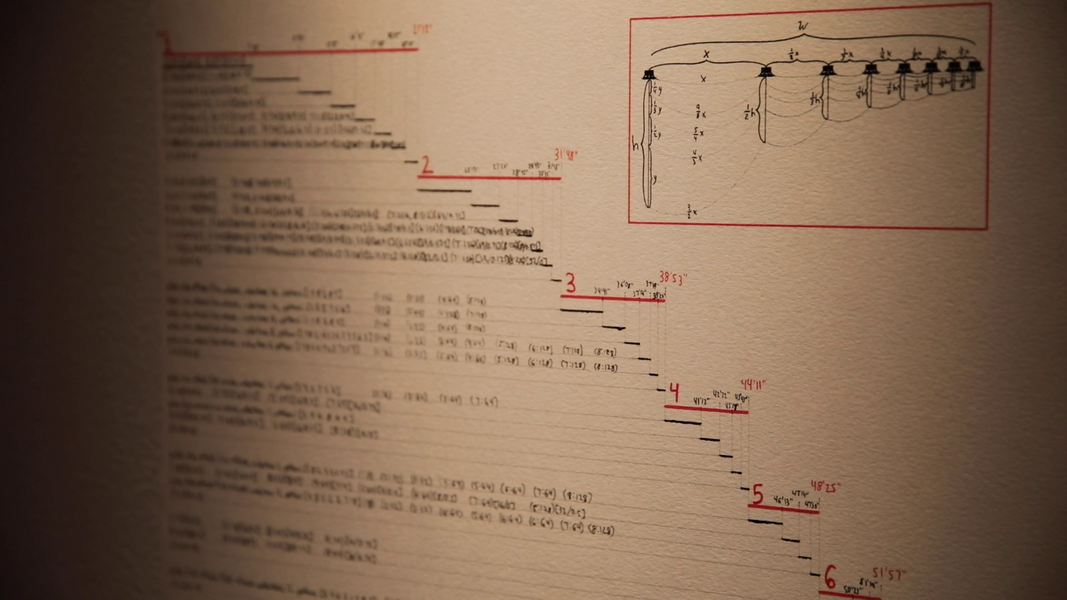 Score detail from "harmonic curtain"harmonic curtain – speakers, steel jack chain, score on paper, 8-channel sound 60’00” (loop) Viewers are confronted with the tactile nature of sound when encountering harmonic curtain, installed above the entrance to the exhibition. The overall shape created by the series of hanging chains recalls the decorative fabric bunting of ornate drapery, rendered as a transparent and vibrating line drawing. The entire form of the work - spatially and temporally - is derived from the harmonic series, the naturally occurring relationship of resonating bodies that we interpret as consonance in music. Rather than hearing harmonic relationships, the viewer-listener experiences this pervasive and fundamental sonic principle through sight and touch. The work illustrates the connections between sound and matter, highlighting the complicated interactions of even simple vibrating systems.
Score detail from "harmonic curtain"harmonic curtain – speakers, steel jack chain, score on paper, 8-channel sound 60’00” (loop) Viewers are confronted with the tactile nature of sound when encountering harmonic curtain, installed above the entrance to the exhibition. The overall shape created by the series of hanging chains recalls the decorative fabric bunting of ornate drapery, rendered as a transparent and vibrating line drawing. The entire form of the work - spatially and temporally - is derived from the harmonic series, the naturally occurring relationship of resonating bodies that we interpret as consonance in music. Rather than hearing harmonic relationships, the viewer-listener experiences this pervasive and fundamental sonic principle through sight and touch. The work illustrates the connections between sound and matter, highlighting the complicated interactions of even simple vibrating systems. -
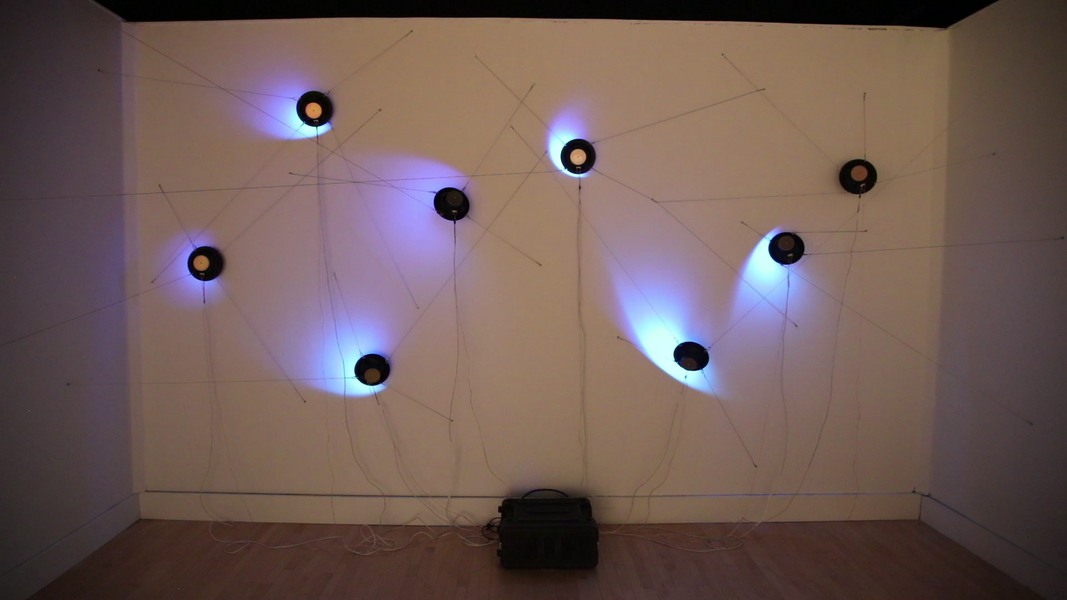 "allegory" installation viewallegory – speakers, LEDs, steel cable, Max/MSP and Touchdesigner software, 8-channel generative sound and light An inversion of Plato’s “Allegory of the Cave,” the tethered bodies in this work are not prohibited from perceiving the objects casting changing shadows on the wall in front of them; rather, the viewer-listener is only able to perceive the light and sound motion of these captive speaker-bodies indirectly. The extremely low frequencies that pulse through each speaker would be inaudible without the implication of their surrounding restraints. They resemble irregular heartbeats, casting the dangling speaker and light wires as an uncanny life support system.
"allegory" installation viewallegory – speakers, LEDs, steel cable, Max/MSP and Touchdesigner software, 8-channel generative sound and light An inversion of Plato’s “Allegory of the Cave,” the tethered bodies in this work are not prohibited from perceiving the objects casting changing shadows on the wall in front of them; rather, the viewer-listener is only able to perceive the light and sound motion of these captive speaker-bodies indirectly. The extremely low frequencies that pulse through each speaker would be inaudible without the implication of their surrounding restraints. They resemble irregular heartbeats, casting the dangling speaker and light wires as an uncanny life support system. -
"allegory" - detailallegory – speakers, LEDs, steel cable, Max/MSP and Touchdesigner software, 8-channel generative sound and light An inversion of Plato’s “Allegory of the Cave,” the tethered bodies in this work are not prohibited from perceiving the objects casting changing shadows on the wall in front of them; rather, the viewer-listener is only able to perceive the light and sound motion of these captive speaker-bodies indirectly. The extremely low frequencies that pulse through each speaker would be inaudible without the implication of their surrounding restraints. They resemble irregular heartbeats, casting the dangling speaker and light wires as an uncanny life support system.
-
 "fate" installation viewfate - speakers, macramé thread, monophonic phase-shifted sound 12’00” (loop) Dozens of thin red cords are tightly strung in parallel between the center of each speaker cone. The speakers undulate like distant lovers, pushing and pulling the thread. The red threads slap against each other in a constant whisper as they oscillate individually, driven by the inaudible speakers they span. The movement increases and decreases, but both speakers always move in equal and opposite directions.
"fate" installation viewfate - speakers, macramé thread, monophonic phase-shifted sound 12’00” (loop) Dozens of thin red cords are tightly strung in parallel between the center of each speaker cone. The speakers undulate like distant lovers, pushing and pulling the thread. The red threads slap against each other in a constant whisper as they oscillate individually, driven by the inaudible speakers they span. The movement increases and decreases, but both speakers always move in equal and opposite directions.
equivocation
In Claude Shannon’s model of communication, “equivocation” refers to the average uncertainty in the message delivered when the message sent is known. After the meaningful message is subtracted from the signal, the residual uncertainty must be due to the noise of the channel. If we are to estimate the fidelity and capacity of the media through which a message is communicated, noise must be present.
This series of drawings on paper explores equivocation using a digital pen plotter. The plotter is capable of rendering very precise images on predetermined paths, with choice of surface and implement introducing the most noise in the final result. In these experiments, however, the plotter’s motors are programmed in real time, leveraging the machine’s unequivocal precision to expose the noise present in the transmission of data to digital movement. The drawings are spatial documents of temporal processes, while the sound magnifies the physicality of the machine’s maneuvers in the installation space.
In some experiments, a simple process is continuously executed without regard for the plotter’s limitations, the pen sometimes moving erratically as the motors struggle to comply with the impossible speeds dictated by the algorithm. In others, the drawing board’s vibrations are captured with piezo microphones and its motors’ electromagnetic fields with telephone taps, attempting to convert these audio signals to position data and back again in iterative cycles. The circuit between “virtual” and “actual” is complicated by feedback – not to achieve equilibrium, but to materialize uncertainty in the translation between different machine epistemologies.
-
"equivocation" sound recordingsThis is a recording including examples of the plotter in action. Four piezo (contact) microphones are attached to the bottom of the rigid drawing surface. Three induction "telephone taps" amplify the motors that move the pen across the surface and up and down. Recordings in order from drawing series: "carrying capacity" "listenjous" "ordinal/digital"
-
THREE PLOTS (2022)improvised "performance" using a modified version of my drawing software and the pen plotter with microphones attached, to demonstrate the techniques used in "equivocation."
-
 "carrying capacity #1""carrying capacity #1" Systems break as their constituent parts exceed the system’s capabilities to support them. Often these breaks cause violent and sudden shifts rather than gradually increasing chaos. The machine draws shapes of expanding diameter. Suddenly, the movements become too large for the motors to complete in the given interval. The marks become increasingly erratic and sparse, and eventually the motors are completely paralyzed with impossible instructions.
"carrying capacity #1""carrying capacity #1" Systems break as their constituent parts exceed the system’s capabilities to support them. Often these breaks cause violent and sudden shifts rather than gradually increasing chaos. The machine draws shapes of expanding diameter. Suddenly, the movements become too large for the motors to complete in the given interval. The marks become increasingly erratic and sparse, and eventually the motors are completely paralyzed with impossible instructions. -
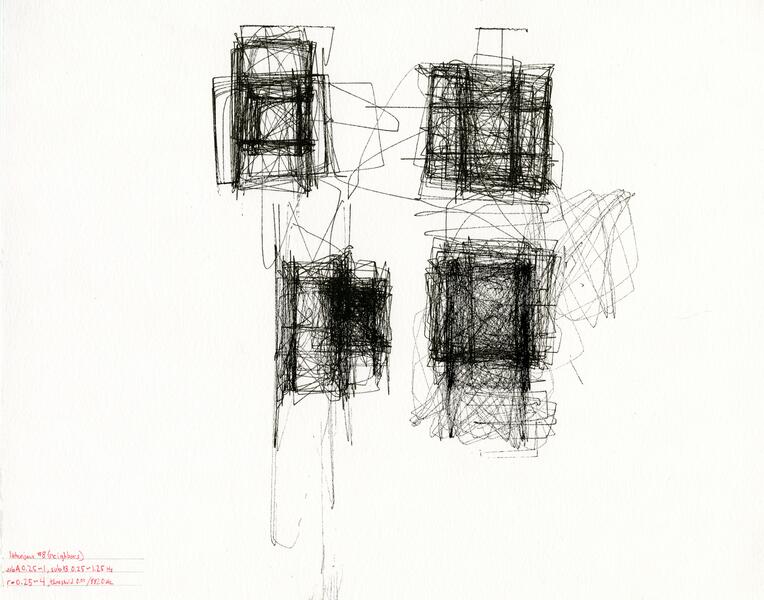 "listenjous #8 (neighbors)""listenjous" The plotter is driven by a single belt looped around two motors, which must work in coordination to move the pen in two dimensions. For example, to make a horizontal straight line, they move at the same speed in the same direction, while a vertical line requires them to move in opposite directions. Curves require one motor to speed up while the other slows down, changing directions. In this experiment, the sound of each motor is picked up by an induction loop “telephone tap” and analyzed for its frequency content. The estimated frequency is fed into a sine or triangle wave oscillator. The two oscillators are plotted against each other as a lissajous curve (a graph useful for visualizing complex harmonic motion). As the sound of each motor is fed back to control its speed, the system approaches equilibrium, creating increasingly simple geometric shapes from the harmonically-related speed of the motors. Eventually the imperfect process of digital sampling and frequency analysis causes the pen to wander off course, starting the process over again elsewhere on the paper.
"listenjous #8 (neighbors)""listenjous" The plotter is driven by a single belt looped around two motors, which must work in coordination to move the pen in two dimensions. For example, to make a horizontal straight line, they move at the same speed in the same direction, while a vertical line requires them to move in opposite directions. Curves require one motor to speed up while the other slows down, changing directions. In this experiment, the sound of each motor is picked up by an induction loop “telephone tap” and analyzed for its frequency content. The estimated frequency is fed into a sine or triangle wave oscillator. The two oscillators are plotted against each other as a lissajous curve (a graph useful for visualizing complex harmonic motion). As the sound of each motor is fed back to control its speed, the system approaches equilibrium, creating increasingly simple geometric shapes from the harmonically-related speed of the motors. Eventually the imperfect process of digital sampling and frequency analysis causes the pen to wander off course, starting the process over again elsewhere on the paper. -
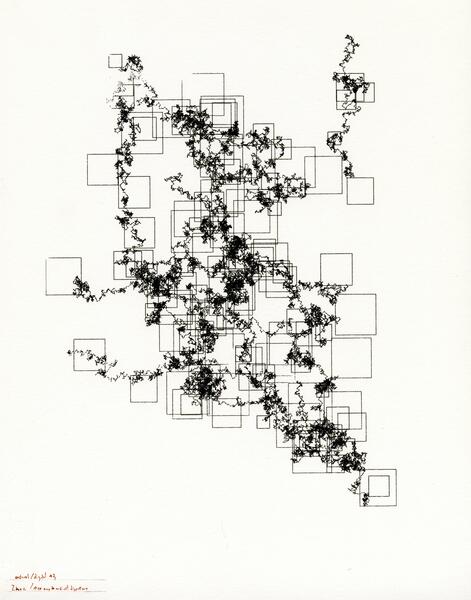 "ordinal/digital #3""ordinal/digital" By comparing the amplitudes of the piezo microphones under the four corners of the drawing surface, the approximate position of the pen on the drawing surface can be determined — theoretically, each microphone should give a higher reading as the pen scratches closer to it. However, because of the small surface, digital sampling error, and the rigid material which easily transmits vibrations to all microphones, the readings are very crude. These experiments start with a simple, predetermined shape, drawing it on the paper and recording amplitude information from each corner’s microphone. In the following iterations, the total original length is broken up into a series of small movements, each at 45-degree angles, toward or away from the corner that had the loudest sample at the corresponding moment of capture.
"ordinal/digital #3""ordinal/digital" By comparing the amplitudes of the piezo microphones under the four corners of the drawing surface, the approximate position of the pen on the drawing surface can be determined — theoretically, each microphone should give a higher reading as the pen scratches closer to it. However, because of the small surface, digital sampling error, and the rigid material which easily transmits vibrations to all microphones, the readings are very crude. These experiments start with a simple, predetermined shape, drawing it on the paper and recording amplitude information from each corner’s microphone. In the following iterations, the total original length is broken up into a series of small movements, each at 45-degree angles, toward or away from the corner that had the loudest sample at the corresponding moment of capture.
feedback bowls
This installation turns inert objects into resonant vessels which sing to themselves. Each steel bowl has a contact microphone and transducer attached, creating a feedback loop across its surface as the microphone picks up the transducer’s output. Software listens and adjusts the signal flow, allowing a variety of sonic results to emerge based on the bowls’ resonant frequencies. The vibrations from visitors’ movement may also add slight disruption to this signal chain, magnified by the exponential nature of feedback.
-
"feedback bowls"sound excerpts from "feedback bowls" in installation. 6'36"
-
 "feedback bowls" installation viewas installed at KANEKO, Omaha, NE, 6-9 July 2016 (Omaha Under the Radar Festival)
"feedback bowls" installation viewas installed at KANEKO, Omaha, NE, 6-9 July 2016 (Omaha Under the Radar Festival) -
 "feedback bowls" detailas installed at Eastern Bloc Gallery, Montreal, QC, 19 June 2015 (Montreal Contemporary Music Lab)
"feedback bowls" detailas installed at Eastern Bloc Gallery, Montreal, QC, 19 June 2015 (Montreal Contemporary Music Lab)


